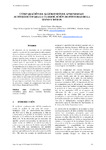Mostrar o rexistro simple do ítem
Comparación de algoritmos de aprendizaje automático para la clasificación de posturas de la mano y dedos
| dc.contributor.author | Otazua, Enaitz | |
| dc.contributor.author | Irigoyen, Eloy | |
| dc.contributor.author | Imatz-Ojanguren, Eukene | |
| dc.contributor.author | Keller, Thierry | |
| dc.date.accessioned | 2019-08-10T17:51:30Z | |
| dc.date.issued | 2019 | |
| dc.identifier.citation | Otazua, E., Irigoyen, E., Imatz-Ojanguren, E, Keller, T. (2019). Comparación de algoritmos de aprendizaje automático para la clasificación de posturas de la mano y dedos. En XL Jornadas de Automática: libro de actas, Ferrol, 4-6 de septiembre de 2019 (pp.211-217). DOI capítulo: https://doi.org/10.17979/spudc.9788497497169.211. DOI libro: https://doi.org/10.17979/spudc.9788497497169 | es_ES |
| dc.identifier.isbn | 978-84-9749-716-9 | |
| dc.identifier.uri | http://hdl.handle.net/2183/23692 | |
| dc.description.abstract | [Resumen] El deterioro de la movilidad de la extremidad superior es una de las consecuencias más comunes de los accidentes cerebrovasculares. La estimulación eléctrica funcional (FES) ha demostrado ser una terapia efectiva para recuperar la movilidad y la función de la mano. Para desarrollar un sistema de control para la aplicación de FES es necesario primero obtener un clasificador capaz de identificar los movimientos de la mano y los dedos. Este estudio contribuye a la fase inicial de este proceso, donde se analiza el comportamiento de diferentes algoritmos durante la clasificación de gestos de la mano durante movimientos de agarre realizados por un voluntario sano. Entre los algoritmos de clasificación utilizados para el reconocimiento del movimiento de agarre, los que mejores resultados han obtenido observando la precisión y tiempo de computación han sido el Extra Trees, Random Forest y SVM. | es_ES |
| dc.description.abstract | [Abstract] Upper limb impairments are one of the most common consequences of stroke. Functional electrical stimulation (FES) has proved to be an effective therapy to restore hand function and mobility. In order to develop a control system for FES applications, it is first necessary to obtain a classifier able to identify hand and fingers movements. This study contributes to the initial phase of this process, where the behaviour of different classification algorithms is analysed for classification of hand gestures during grasping movements of a healthy volunteer. Among the classification algorithms used for the recognition of hand and finger movements, the oneswith the best results regarding the accuracy and computing time have been Extra Trees, Random Forest and SVM. | es_ES |
| dc.language.iso | spa | es_ES |
| dc.publisher | Universidade da Coruña, Servizo de Publicacións | es_ES |
| dc.relation.uri | https://doi.org/10.17979/spudc.9788497497169.211 | |
| dc.rights | Atribución-NoComercial-CompartirIgual 4.0 | es_ES |
| dc.rights.uri | http://creativecommons.org/licenses/by-nc-sa/4.0 | * |
| dc.subject | Clasificación | es_ES |
| dc.subject | Aprendizaje automático | es_ES |
| dc.subject | Mano | es_ES |
| dc.subject | Dedos | es_ES |
| dc.subject | Sensores inerciales | es_ES |
| dc.subject | Sensores vestibles | es_ES |
| dc.subject | Classification | es_ES |
| dc.subject | Machine learning | es_ES |
| dc.subject | Hand | es_ES |
| dc.subject | Fingers | es_ES |
| dc.subject | Inertial sensors | es_ES |
| dc.subject | Wearable sensors | es_ES |
| dc.title | Comparación de algoritmos de aprendizaje automático para la clasificación de posturas de la mano y dedos | es_ES |
| dc.title.alternative | Comparison of machine learning algorithms for classification of hand and finger postures | es_ES |
| dc.type | conference output | es_ES |
| dc.rights.accessRights | embargoed access | es_ES |
| dc.date.embargoEndDate | 2019-08-25 | es_ES |
| dc.date.embargoLift | 2019-08-25 | |
| UDC.startPage | 211 | es_ES |
| UDC.endPage | 217 | es_ES |
| dc.identifier.doi | https://doi.org/10.17979/spudc.9788497497169.211 | |
| UDC.conferenceTitle | XL Jornadas de Automática | es_ES |
| UDC.coleccion | Publicacións UDC | es_ES |






